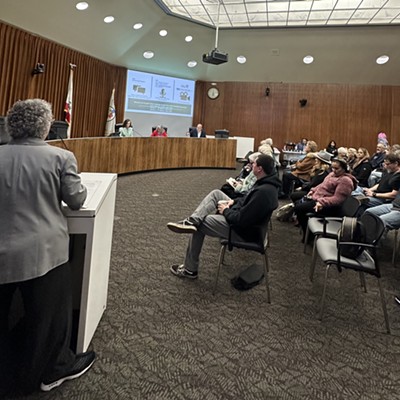The decision to switch ambulance providers in Santa Barbara County was the single most important vote Bob Nelson has made as a supervisor, the 4th District representative told the Sun.
“I can’t imagine too many more votes I’ll have that will have more consequences than this. It really means a new era of public safety for our residents,” Nelson said.
On Sept. 19, the Santa Barbara County Board of Supervisors unanimously approved the Santa Barbara County Fire Department as the new provider for emergency medical services and voted 4-1 (with 5th District Supervisor Steve Lavagnino dissenting for fear of litigation) to deny the application of its current provider, American Medical Response (AMR).
“Historically we just renewed the contracts with AMR, but that process doesn’t allow for us to ask for more. We can’t rethink the system, it was very prescribed,” Nelson said.
Now, AMR is preparing to sue the county for its decision based on state emergency medical services laws, and the Coalition for Labor, Agriculture, and Business (COLAB) is questioning the legitimacy of this transition as the county allowed its Fire Department to purchase 35 ambulances prior to reaching any agreement.
Santa Barbara County Fire Chief Mark Hartwig and other county officials told the Sun that the county has acted within its legal bounds and will have actions in place to ensure a smooth transition.
“AMR has had a monopoly on emergency medical services for more than 50 years, and it doesn’t surprise me one bit that they would use legal means to continue to fight for that,” Nelson said.
AMR served Santa Barbara County in an exclusive contract where the company acted as the sole ambulance provider for county residents in accordance with the state law. In 2019, the county issued a request for proposal (RFP) to see what could be done to make adjustments to the current system.
“Our initial concept was to have a conversation about what the system would look like and how we can integrate emergency medical services systems in the county so we aren’t so siloed,” Nelson said.
County Fire and AMR responded to the RFP in May 2022, and both proposals were scored by an independent review panel. Although the Board of Supervisors felt that County Fire had the strongest capabilities to create a more transparent, integrated system that aligned with their goals, the panel scored AMR 317 points higher than County Fire, and the county’s Local Emergency Medical Services Agency (LEMSA), which oversees ambulance services, awarded the contract to AMR.
After AMR’s proposal was approved, the Board of Supervisors switched to a nonexclusive ambulance services agreement in April 2023. The nonexclusive program set up a tiered system and a new permitting process where applicants could apply for specific ambulance services: emergency medical calls; interfacility transport and special events transport; or critical care transport.
AMR only applied for emergency medical calls and County Fire applied for all three categories.
“I was fully prepared to have [County] Fire and AMR be awarded a permit,” Nelson said. “There would have definitely been some processes we had to figure out, but I walked in ready to do that, but AMR and the county said they needed 100 percent of the market to be feasible.”
AMR Vice President of Operations Mike Rice told the Sun that the county’s decision violated the California EMS Law, which creates a specific process for allowing exclusive ambulance services, like following an RFP.
“When it came to the point where AMR won, that’s when [the supervisors] opted to throw it out,” Rice said. “The law requires the county to designate LEMSA, an agency to provide regulatory oversight, and they are the only ones allowed to set policies, rules, and procedures governing ambulance providers.”
The Board of Supervisors doesn’t have the authority to set those policies, he added, neither does it have the authority to pick a provider in the way the supervisors did, he added. By only selecting County Fire and not awarding AMR, the board created an exclusive system after moving to the nonexclusive agreement.
“To go from winning a competitive process by 317 points to not even being issued a permit is pretty disappointing, and it says a lot about the process and calls into question whether or not the patients and community are front of mind when it comes to this system,” Rice said.
AMR will continue providing ambulance services until March 2024 when the current contract is up, he said, and AMR’s working to keep its employees based in Santa Barbara County within the company, just in different service areas.
“I just think that as much as these things become complicated with politics and law and everything, we have to remember how this impacts our employees, and what’s hard for me is this uncertainty and making decisions on what their futures will look like,” Rice said.
Andy Caldwell, the executive director for COLAB, said that he has issues with the county’s decision because it ignored the original RFP.
“The county throws out the exclusive ambulance contract and says we’re going with a nonexclusive ambulance contract, and then they give the nonexclusive contract exclusively to County Fire,” Caldwell said. “What they did was they changed horses in the middle of the race while pretending it’s ethical, fair, and transparent.”
Allowing the Board of Supervisors the final say pulled the decision away from an independent evaluation and from professional experts’ input that was considered during the RFP process, he added.
“I’ve never seen anything like this in 32 years. This is the most politicized board I’ve ever seen and one of many occasions where they’re shafting the private sector,” Caldwell said.
Caldwell submitted California Public Records Act requests to the county for emails surrounding the contracts and said that he’s seen documents with concerns expressed by hospital CEOs about how critical care transfers and interfacility transfers will be handled and general concerns from the county’s LEMSA staff.
“In the documents, you can tell they are clearly frustrated and feel threatened,” he said.
Caldwell declined to share the documents with the Sun to protect those included who are “fearful of their jobs.”
Sue Anderson, president and CEO of Marian Regional Medical Center, told the Sun in an email that Marian will work with whichever provider the county places in charge of ambulance services.
“Our main concern is that we work closely with the chosen partner to make sure our community is well cared for and there will not be delays in service,” Anderson said.
Before a provider was selected and contracts were still in the works, the Santa Barbara County Debt Advisory Committee approved a County Fire purchase of 35 ambulances—something Caldwell said didn’t happen with proper authorization.
“The Debt Advisory Committee is not the approver of purchases, it’s whether borrowing money for something is advisable and they advise the board yes or no, they don’t approve purchases,” he said.
County Public Information Officer Kelsey Buttitta told the Sun in an email that the Debt Advisory Committee had authority to approve the purchase because the Fire Department went through a request for proposal process to purchase goods.
“This was a properly bid RFP to purchase goods. Because of this, it was within the purchasing agents’ authority to award the purchase order without going to the board and was kept within the county departments,” Buttitta said in her email.
County Fire Chief Hartwig said that the department had to purchase ambulances in advance in order to participate in the bidding process.
“As we talked with fire staff and the CEO’s Office, I said I was willing to make the investment knowing these are generic van conversions into ambulances that we could get at a really good price,” Hartwig said. “If we didn’t get them we could sell them for what we got them for.”
Regarding concerns about response times, he added that County Fire developed a transition plan to ensure there’s no gap in service and all calls will be answered in a timely manner.
“There’s details to that planning, but there’s redundant systems and plans in place so when something happens we have a backup plan,” Hartwig said.
Countywide, fire chiefs have joined in on the ambulance service discussion for the last five years to figure out ways to add more resources and create more programs to help improve the care for county constituents, he said.
“I don’t get a pay raise for this, I probably get more work. The cities and firefighters don’t get anything, [but] they get more services on the street and improved services to the people that we help every day,” Hartwig said.
Reach Staff Writer Taylor O’Connor at [email protected].










